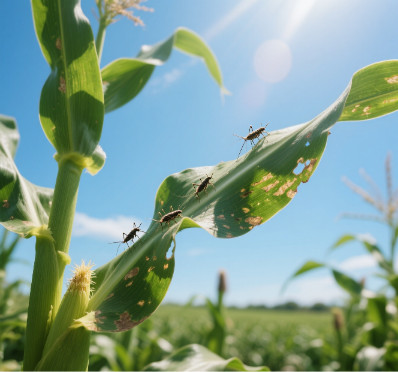Thrips are minute insects belonging to the order Thysanoptera and have emerged as one of the most formidable adversaries in global agriculture. These seemingly insignificant creatures, measuring just 1–2 mm in length, inflict devastating economic losses and pose a severe threat to food security. Four species stand out for their rapid global expansion, destructive feeding habits, and role as vectors for deadly plant viruses: Western flower thrips (Frankliniella occidentalis), onion thrips (Thrips tabaci), chilli thrips (Scirtothrips dorsalis), and melon thrips (Thrips palmi). A recent review by the Chinese Academy of Agricultural Sciences (CAAS) in Entomologia Generalis sheds light on the mechanisms driving their success and proposes integrated strategies to combat this escalating crisis.
The Dual Threat: Feeding Damage and Virus Transmission
Thrips wreak havoc through dual mechanisms. First, they pierce plant tissues with their rasping-sucking mouthparts, causing silvering, scarring, deformation, and premature senescence in leaves, flowers, and fruits. Indirectly, thrips transmit over 20 plant viruses, including the tomato spotted wilt virus (TSWV) and the impatiens necrotic spot virus (INSV). These viruses affect over 1,000 plant species. These viruses often cause more severe damage than the insects themselves, leading to crop failures and economic ruin for farmers worldwide. For example, TSWV alone is estimated to cause losses exceeding $1 billion annually in the United States. Global losses attributed to thrips-transmitted viruses are projected to surpass $20 billion by 2030 (FAO, 2024).
Key Drivers of Global Domination
- Biological Advantages
-
- Rapid Reproduction and Adaptability: Thrips have short life cycles (10–20 days) and reproduce prolifically (30–80 eggs per female), often through parthenogenesis (asexual reproduction). Their polyphagous diet, which spans over 500 plant species, ensures their survival in resource-limited environments. For instance, a single female *Frankliniella occidentalis* can establish a population of over 10,000 individuals within two months under optimal conditions.
- Environmental Resilience: Species like Frankliniella occidentalis demonstrate exceptional thermal tolerance, thriving in both tropical and temperate climates. Research indicates that they can survive temperatures ranging from -10°C to 40°C, enabling them to expand into regions that were previously uninhabitable.
- Insecticide Resistance: Alarmingly, thrips can rapidly evolve resistance through metabolic detoxification enzymes (e.g., cytochrome P450) and target-site mutations (e.g., GluCl gene amplification). In China, F. occidentalis has developed resistance to common insecticides, rendering chemical control ineffective. A study in Shandong Province revealed that, within just five years, populations of *F. occidentalis* exhibited 98% resistance to abamectin, a widely used pesticide.
- Competitive Supremacy: Invasive thrips outcompete native species by aggressively exploiting resources and displacing local populations. They do so through superior thermal adaptation and ecological dominance. Field experiments in California demonstrated that F. occidentalis outcompeted native thrips species by 70% within six months by monopolizing food resources.
- Virus-Thrips Symbiosis: Infected plants emit volatile compounds that attract more thrips, creating a positive feedback loop. Larvae acquire viruses while feeding and become lifelong vectors, perpetuating outbreaks. Notably, virus-infected *F. occidentalis* individuals transmit TSWV with an efficiency three times higher than uninfected individuals, accelerating the spread of the disease.
Global Expansion Catalysts
Climate Change and International Trade: Warmer temperatures expand the range of thrips (e.g., S. dorsalis spread from South Asia to the global tropics in two decades). The global trade of ornamental plants and crops unknowingly transports infested materials across borders. According to a study by the European Plant Protection Organization (EPPO), 30% of thrips introductions intercepted in Europe occur through imported ornamental plants, with 60% of these incidents involving *F. occidentalis*.
Agricultural Practices: Monocultures, high nitrogen fertilization, and the overuse of broad-spectrum insecticides disrupt natural enemy populations, creating ideal conditions for thrips proliferation. A meta-analysis of 50 Brazilian farms revealed that fields with nitrogen fertilization rates exceeding 200 kg/ha had thrips populations 2.5 times higher than fields with balanced fertilization.
Emerging Solutions: A Multi-Faceted Approach
- Biological Control:Predatory mites (Amblyseius herbicolus) reduced thrips populations by 83% in Brazilian pepper crops. Entomopathogenic fungi (Beauveria bassiana) disrupted mating and ovary development, suppressing reproduction by up to 65% in greenhouse trials.
- Genomic and Biotech Innovations: The sequenced genome of Thrips hawaiiensis (287.59 Mb) enables targeted gene editing and RNA interference (RNAi) to silence essential genes, offering precise pest control. Laboratory experiments using RNAi against a key reproduction gene in Frankliniella occidentalis reduced egg hatch rates by 90%.
- Integrated Pest Management (IPM): Combining blue sticky traps for monitoring, habitat manipulation (e.g., intercropping with repellent plants, such as marigolds, which reduce thrips landing by 40%), and selective insecticides (e.g., spinetoram) with biological agents minimizes environmental impact while maintaining efficacy.
- International Collaboration: The CAAS study advocates for:
-
- Global surveillance networks for early detection that leverage AI-driven monitoring systems with 95% accuracy to identify thrips infestations within 48 hours.
- Harmonized quarantine protocols to prevent the spread of thrips. The EPPO recommends mandatory phytosanitary treatments for all imported plant materials, which could reduce new introductions by 50%.
- Joint research and development (R&D) on resistance-breaking insecticides and biocontrol agents. A consortium of G20 nations is investing $500 million over five years to develop novel pest management technologies.
Conclusion
Thrips exemplify how small pests can escalate into global crises when empowered by biological adaptations, human activities, and ecological vulnerabilities. With annual losses mounting in the billions of dollars, sustainable management requires a combination of genomic science, biocontrol, and international policy coordination. Urgent action is imperative to safeguard food security and mitigate the looming threat of thrips-driven crop devastation. If left unchecked, thrips-related losses could surpass $30 billion annually by 2030, endangering food supplies for millions. Only through multifaceted, science-driven collaboration can this global agricultural crisis be contained.
Keywords: thrips invasion, insecticide resistance, virus transmission, biological control, global pest management.
Sources:
- CAAS review in Entomologia Generalis
- FAO Global Pest Risk Assessment Report (2024).
- EPPO Pest Surveillance Data (2023)
- University of California Cooperative Extension field trials
- Genomic studies from the International Thrips Research Consortium









